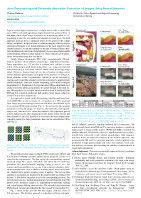Joint Demosaicing and Chromatic Aberration Correction of Images Using Neural Networks
Charles Malleson and Adrian HiltonCentre for Vision, Speech & Signal Processing University of Surrey, United Kingdom CVMP 2019
Abstract
Typical colour digital cameras have a single sensor with a colour filter array (CFA), each pixel capturing a single channel (red, green or blue). A full RGB colour output image is generated by demosaicing (DM), i.e. interpolating to infer the two unobserved channels for each pixel. The DM approach used can have a significant effect on the quality of the output image, particularly in the presence of common imaging artifacts such as chromatic aberration (CA). Small differences in the focal length for each channel (lateral CA) and the inability of the lens to bring all three channels simultaneously into focus (longitudinal CA) can cause objectionable colour fringing artifacts in edge regions. These artifacts can be particularly severe when using low-cost lenses. We propose to use a set of simple neural networks to learn to jointly perform DM and CA correction, producing high quality colour images subject to severe CA as well as image noise. The proposed neural network-based joint DM and CA correction produces a significant improvement in image quality metrics (PSNR and SSIM) compared the baseline edge-directed linear interpolation approach preserving image detail and reducing objectionable false colour and comb artifacts. The approach can be applied in the production of high quality images and video from machine vision cameras with low cost lenses, thus extending the viability of such hardware to visual media production.
Citation
@inproceedings{Malleson_CVMP2019,
author = {Malleson, Charles and Hilton, Adrian},
booktitle = {European Conference on Visual Media Production (CVMP), short paper},
title = {{Joint Demosaicing and Chromatic Aberration Correction of Images Using Neural Networks}},
year = {2019}
}
